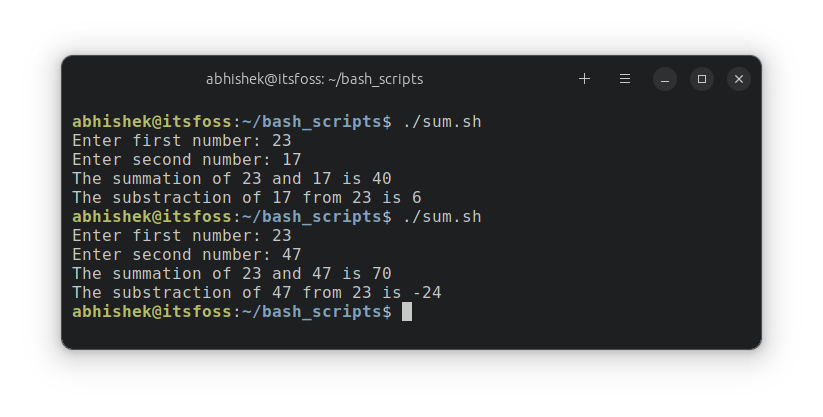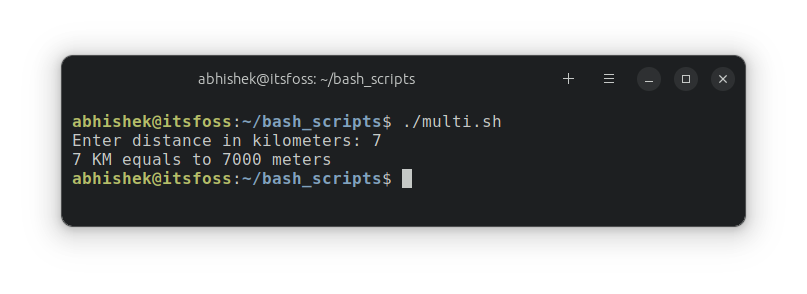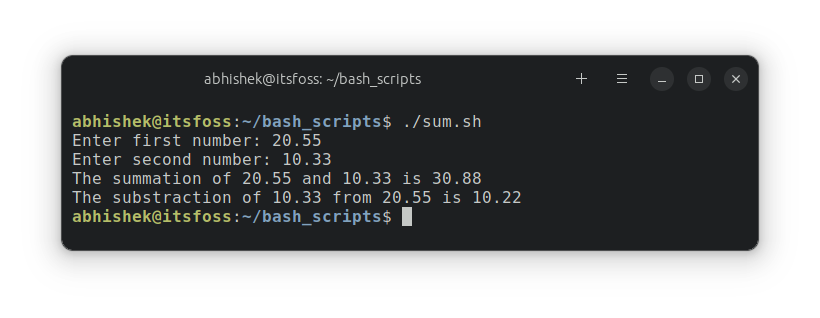

Bash 基础知识系列 #4:算术运算
source link: https://www.51cto.com/article/760753.html
Go to the source link to view the article. You can view the picture content, updated content and better typesetting reading experience. If the link is broken, please click the button below to view the snapshot at that time.


你可以使用 Bash 脚本做很多事情。对变量执行简单的算术运算就是其中之一。
Bash shell 中算术运算的语法如下:
$((arithmetic_operation))假设你必须计算两个变量的总和。你这样做:
sum=$(($num1 + $num2))(()) 内空格的使用没有限制。你可以使用 $(( $num1+ $num2))、$(( $num1+ $num2 )) 或者 $(( $num1+ $num2 ))。它们都一样。
在通过示例详细讨论之前,我先分享一下它支持的算术运算符。
Bash 中的基本算术运算符
以下是 Bash shell 中算术运算符的列表。
| |
| |
| |
| 整数除法(不带小数) |
| 模除法(仅余数) |
| 求幂(a 的 b 次方) |
🚧 Bash 不支持浮点数(小数)。你必须使用其他命令(例如
bc)来处理它们。
Bash 中的加法和减法
让我们通过编写一个脚本来看看它,该脚本从用户那里获取两个数字,然后打印它们的总和和减法。
#!/bin/bash
read -p "Enter first number: " num1
read -p "Enter second number: " num2
sum=$(($num1+$num2))
sub=$(($num1-$num2))
echo "The summation of $num1 and $num2 is $sum"
echo "The substraction of $num2 from $num1 is $sub"我相信你熟悉上一章中使用 read 命令来 在 Bash 中接受用户输入。
你应该关注这两行:
sum=$(($num1+$num2))
sub=$(($num1-$num2))将此脚本保存为 sum.sh 并运行它。给它一些输入并检查结果。

Example of addition and subtraction in Bash shell script
Bash 中的乘法
现在让我们转向乘法。
这是一个将公里转换为米的示例脚本(这给美国读者带来了麻烦 😄)。作为参考,1 公里等于 1000 米。
#!/bin/bash
read -p "Enter distance in kilometers: " km
meters=$(($km*1000))
echo "$km KM equals to $meters meters"将脚本保存为 multi.sh,赋予其执行权限并运行它。这是一个示例输出:

Multiplication in bash script
看起来不错,不是吗? 让我们继续进行除法。
Bash 脚本中的除法
让我们用一个非常简单的脚本来看看除法:
#!/bin/bash
num1=50
num2=5
result=$(($num1/$num2))
echo "The result is $result"你很容易猜到结果:
The result is 10没关系。但是让我们更改数字并尝试将 50 除以 6。结果如下:
The result is 8但这不正确。 正确答案应该是 8.33333。
这是因为 Bash 默认情况下只处理整数。你需要额外的命令行工具来处理浮点(小数)。
最流行的工具是 bc,它是一种处理数学运算的非常强大的计算器语言。不过,你现在不需要关注细节。
你必须通过管道将算术运算“回显”给 bc:
echo "$num1/$num2" | bc -l于是,将之前的脚本修改为:
#!/bin/bash
num1=50
num2=6
result=$(echo "$num1/$num2" | bc -l)
echo "The result is $result"现在你得到结果:
The result is 8.33333333333333333333请注意 result=$(echo "$num1/$num2" | bc -l),它现在使用你在 本系列第 2 章 中看到的命令替换。
-l 选项加载标准数学库。默认情况下,bc 最多保留 20 位小数。你可以通过以下方式将比例更改为较小的位数:
result=$(echo "scale=3; $num1/$num2" | bc -l)让我们看看 Bash 中浮点的更多示例。
在 Bash 脚本中处理浮点
让我们修改 sum.sh 脚本来处理浮点。
#!/bin/bash
read -p "Enter first number: " num1
read -p "Enter second number: " num2
sum=$( echo "$num1+$num2" | bc -l)
sub=$( echo "scale=2; $num1-$num2" | bc -l)
echo "The summation of $num1 and $num2 is $sum"
echo "The substraction of $num2 from $num1 is $sub"现在尝试运行它,看看是否可以正确处理浮点:

Floating points in bash script
🏋️🤸 练习时间
是时候一起做一些数学和 Bash 练习了。
练习 1:创建一个脚本,接受以 GB 为单位的输入并以 MB 和 KB 为单位输出其等效值。
练习 2:编写一个带有两个参数并以指数格式输出结果的脚本。因此,如果输入 2 和 3,输出将为 8,即 2 的 3 次方。
提示:使用幂运算符 **。
练习 3:编写一个将摄氏度转换为华氏度的脚本。
提示:使用公式 F = C x (9/5) + 32。你必须在此处使用 bc 命令。
你可以在社区中讨论练习及其方案。
在下一章中,你将 了解 Bash 中的数组。敬请关注。
Recommend
About Joyk
Aggregate valuable and interesting links.
Joyk means Joy of geeK